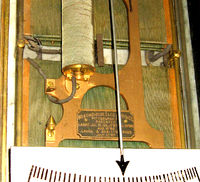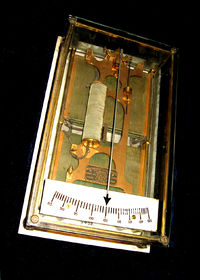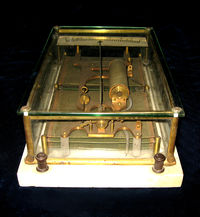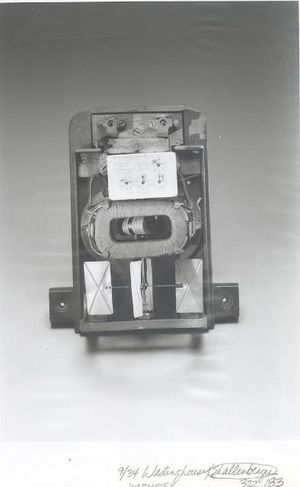Electric Meter
Oliver B. Shallenberger Invents the A.C. Watt-Hour Meter
On 14 August 1888 in Pittsburgh, Pennsylvania, Oliver B. Shallenberger received a patent for the watt-hour meter, a device that measured the amount of A.C. current and made possible the business model of the electric utility.
Shallenberger was a former naval officer hired by the Westinghouse Electric & Manufacturing Co. By 1888, he rose to the power of its chief electrician. Westinghouse was fighting the “War of the Currents” in the 1880s against Thomas Edison. Westinghouse, which had purchased the rights to Nikola Tesla’s polyphase system, was trying to expand the reach of alternating current (A.C.) in American homes. Edison’s system of direct current (D.C.) was the American standard at the time, but it was less practical for residential use.
For example, Edison failed to develop a simple means of measuring how much power a consumer had used. Initially, he charged per lamp, but soon switched to a chemical method to measure amperes per hour. He installed an jar containing two zinc plates submerged in a zinc-sulfate electrolyte. As electricity flowed through the jar, it dissolved zinc off the positive plate and onto the negative one. Each month, workers checked to see how much zinc had moved. Edison actually preferred this messy and time-consuming process to a mechanical method, but its accuracy was questionable.
Working on applications for A.C. power, Shallenberger stumbled onto a solution for the problem of metering. As he was tinkering with an electric arc lamp in 1888, a spring fell out and fell on a ledge inside the lamp. Shallenberger saw that the spring had rotated. Testing a hunch, he discovered that the lamp’s spinning electromagnetic fields had caused the spring to turn. Within a few weeks, Shallenberger designed a wheel that turned in relation to this rotational force, offering a means of measuring amperes per hour on an alternating current circuit.
Hundreds of thousands of these meters were built in the coming decades, allowing A.C. power to take off as an everyday consumer technology. Shallenberger’s basic design remains in use today. Because these meters operated on electrical current’s induced magnetic field, they consumed virtually no power. Consumers could feel more confident that they were only being charged for the power they used, and could more accurately monitor their consumption.
Oliver B. Shallenberger Develops Westinghouse - Tesla Polyphase System Line Galvanometer Indicator with Philip Lange

What can be seen is a total of seven coils in this particular Tesla Polyphase System Galvanometer / Voltmeter; but six of the seven coils are unlike coils that are of the familiar round cylindrical form.

The Westinghouse line galvanometer voltmeter shown here constructed under the combined patents awarded to Shallenberger and Lange and assigned to the Westinghouse Electric and Manufacturing Co. between 1887 and 1890, clearly show that the design is integral to handling electrical current developed and maintained under the Tesla Polyphase or "three-phase" system of electrical production and distribution. Looking close at the finely wound thin green wire coil system, one can immediately see the implementation of the "three-phase" concept. The meter herein pictured covered by Shallenberger and Lange patents include some of the following patents, while other patents by Lange or Lange and co-patentee Byllesby pertain to other applications ultimately used in the Tesla Polyphase System's development and application.
These patents are as follows:
Patent No. 366.374 - filed December 1, 1880 - granted July 12, 1887.[[1]]Inventors: Philip Lange and Henry M. Byllesby. Assigned to Westinghouse. Entitled: "A Circuit Controller for Electrical Circuits."
Patent No. 366,407 - filed December 2, 1886 - granted July 12, 1887.[[2]]Inventor: Philip Lange. Assigned to Westinghouse. Entitled: "Electric Switch." Draft shows a combination twist "T" handle / rocker line switch for commercial use in home and office lighting installations.
Patent No. 366,408 - filed December 2, 1886 - granted July 12, 1887.[[3]]Inventor: Philip Lange. Assigned to Westinghouse. Entitled: "Core for Electro Magnets and Method of Forming Same."

Patent No. 366,410 - filed January 21, 1888 - granted July 31, 1888.[[4]]Inventors: Philip Lange and Oliver B. Shallenberger. Assigned to Westinghouse. Entitled: "Electric Galvanometer."
Patent No. 386,992 - filed October 29, 1887 - granted July 31, 1888.[[5]]Inventor: Philip Lange. Entitled: "Galvanometer." Assigned to Westinghouse. Like the original Edison designed "chemical Meter" used to measure inline D.C. current, this A.C. patent by Lange employed the use of a light bulb as well in its design. The Edison "chemical meter" system was used to measure amperes per hour - so that the commercial user could be charged accordingly for usage. Prior to this, Edison billed users with a per lamp charge, a method which was not in any way accurate as to electrical consumption or load draw.
Patent No. 386,993 - filed January 21, 1888 - granted July 31, 1888.[[6]]Inventor Philip Lange. Entitled: "Galvanometer." Assigned to Westinghouse, the patent draft shows a meter indicator / coil arrangement attached to a A.C. electric dynamo and such embodies some characteristics of design incorporated in the Westinghouse meter pictured herein bearing the Lange and Shallenberger issued patents between 1887 and 1890.
Patent No. 434,151 - filed September 1, 1887- granted August 12, 1890.[[7]]Inventors: Philip Lange and Oliver B. Shallenberger. Assigned to Westinghouse. Entitled: "Switch for Electrical Circuits." The patent draft shows a combination three-conductor point knife switch for use in Polyphase A.C. electrical systems.
Patent No. 434,154 - filed May 15, 1890 - granted August 12, 1890.[[8]]Inventor Philip Lange. Entitled: "Electric Indicator." Assigned to Westinghouse. The patent draft shows a meter / coil arrangement similar to the Westinghouse meter pictured herein bearing the Lange and Shallenberger patents issued between 1887 and 1890.
In all cases, Oliver B. Shallenberger, as chief electrician at the Westinghouse Electric and Manufacturing Co., following William Stanley, Jr.'s leave, oversaw the development of the Tesla Polyphase System to fruition. Such ancillary developments as the 1890 Shallenberger and Lange A.C. inline galvanometer / voltmeter / indicator and also Shallenberger's own A.C. watt-hour meter covered by his August 14, 1888 patent as assigned to the Westinghouse Electric and Manufacturing Co. - contributed greatly to the cohesiveness of the entire alternating-current (A.C.) polyphase "three-phase" system, which to this day, is still based essentially on this same state-of-the-art concepts developed by Westinghouse Electric and Manufacturing Co. over a century ago.
